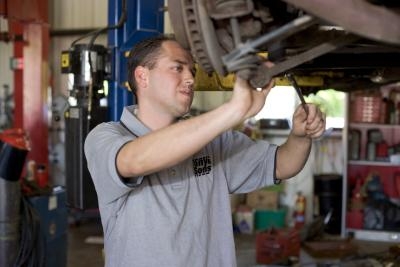
Transmission leaks are very common and cause a great deal of frustration when trying to repair them. Even though a great deal of progress has been made in gasket sealing technology, if the bushing inside of the transmission is worn, replacing a leaking seal will not work to stop the leak. The underlying cause of the leak must be repaired first before replacing the seal. This problem, along with transmission pan leaks, are quick to diagnose but at times very expensive to repair.
Jack up the car and install jack stands under the front control arms. From underneath the car, use a flashlight to locate the general area of the leak. Search thoroughly because air blowing underneath the car can spread the fluid about and make it difficult to locate the source of the leak. Clean the excess fluid and let the car idle until the leak develops and is more easily identified.
Examine the area where the transmission attaches to the engine. If the leak is coming from this location, the transmission will have to be removed, which is an expensive repair. This area is where the torque converter aligns with the transmission pump. Chances are good that the pump bushing has worn, causing fluid to seep past the seal. It is usually best to install a rebuilt pump, rebuilt torque converter and new front seal.
Look at the output shaft seals. This is where the front axles or rear drive shaft connect to the transmission. There are two seals on a front-wheel-drive car. There is only one seal on a rear-wheel-drive model. Replacing the front-wheel-drive axle seals is a viable option---without replacing the axle shaft bushings. Front wheel-drive axles are more stable, and bushing failure is less frequent. Rear-axle drive shafts are longer, heavier and can damage a shaft busing more easily. If the leak is at a rear tail-shaft housing, replace the tail-shaft busing and seal.
Inspect the transmission pan. If the leak is coming from the transmission pan, remove the pan and replace the gasket. The best way to replace the gasket is to thoroughly clean the mating surfaces and make sure they are dry and oil-free. Apply a small amount of gasket sealer to the pan and place the gasket on the sealer. Press gently, then turn the pan over and place it onto a flat surface. Allow the gasket sealer to thoroughly dry and firmly hold the gasket in place. Replace the pan and do not overtighten the bolts and deform the gasket.
Examine the transmission lines that run from the transmission to the radiator. If the lines are damaged and leaking, repair or replace the line. Some are steel lines, while others are rubber hose. Steel lines with cracks or breaks in them can be welded by specialty welders with sophisticated equipment. Rubber hoses are readily available at auto parts stores. Measure the diameter and length of the hose and ask for a hose that is compatible with transmission fluid.